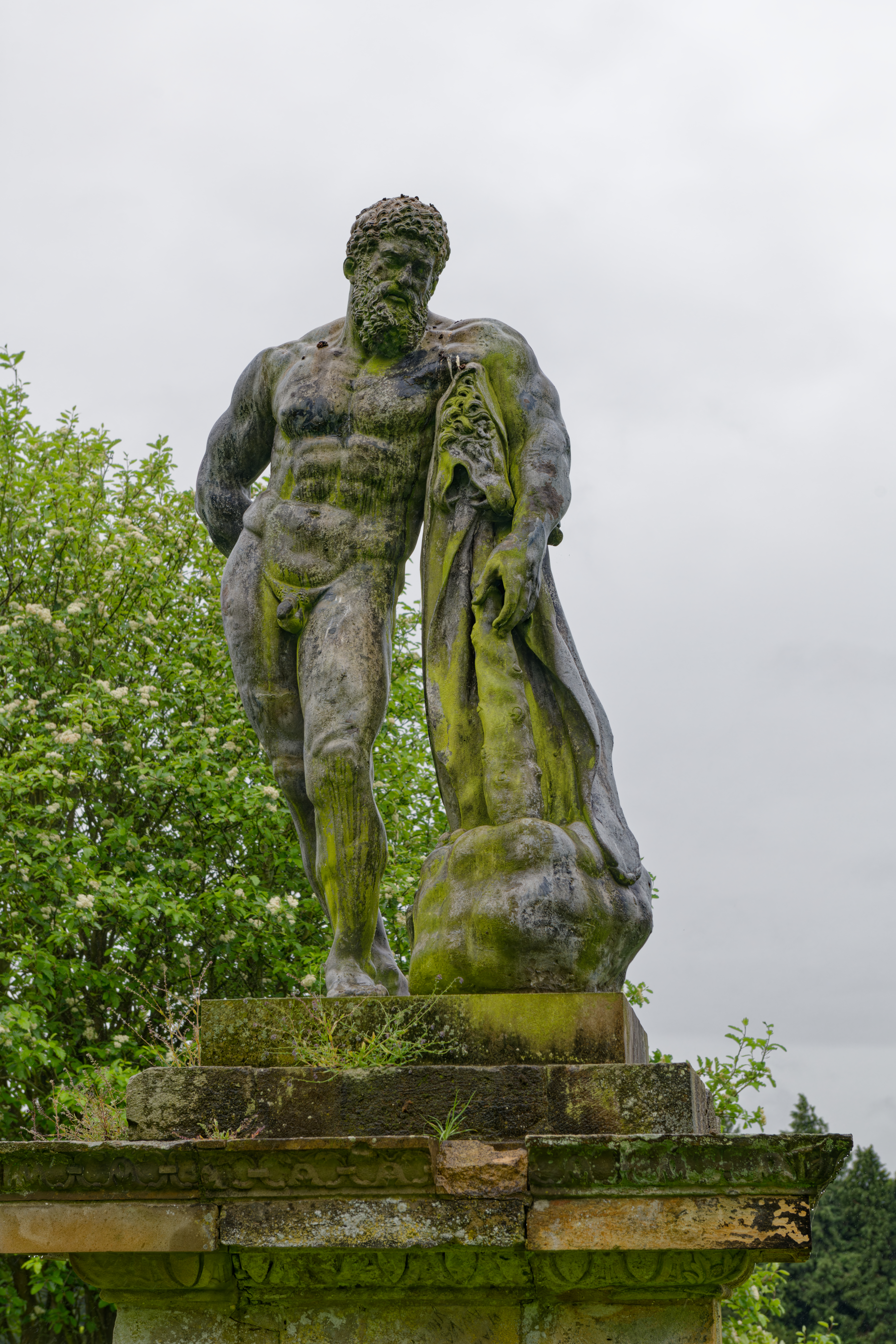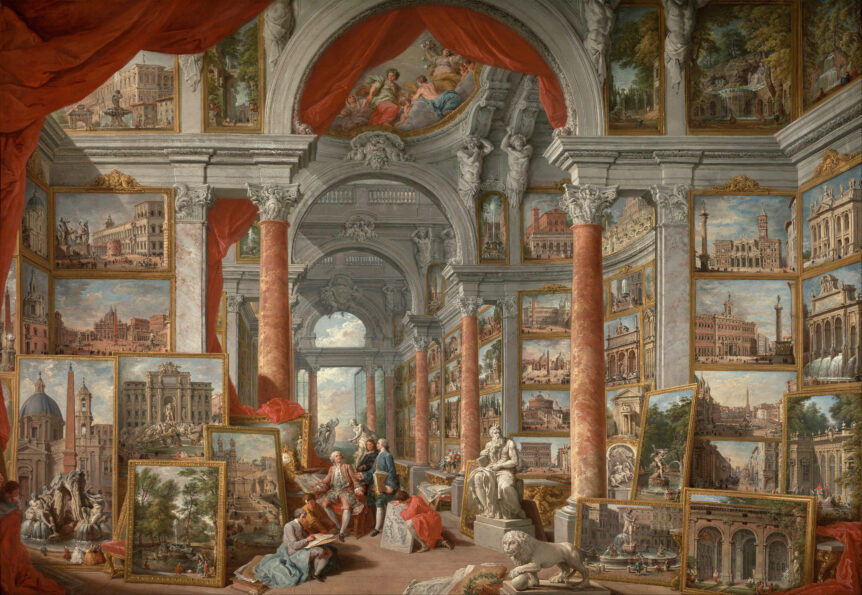The Grand Tour began as a way for young men of means to see Europe, and resulted in the invention of what became modern tourist souvenirs.
When Samuel Johnson remarked that “a man who has not been to Italy is always conscious of an inferiority, from not having seen what it is expected a man should see,” he testified to the near-universal expectation of his time that as aristocratic boys come of age, they simply must embark on the Grand Tour. On the Grand Tour, British upperclass gentlemen closed their days of schooling with an often open-ended campaign of touristic conquest through the remains of the ancient world of continental Europe. The era of the Grand Tour can be said to have begun as early as 1613, when Thomas Howard, fourteenth earl of Arundel (1585–1646), along with his wife and children, embarked on an extensive tour through Italy. They were followed by other families, but mostly by younger men eager to see the world. And as with many cultural practices imbued with social weight, those who completed their Grand Tour wanted objects that spoke of their qualifications. From this simple desire, the modern tourist tchotchke was born.

For the roughly 250 years between 1613 and the 1870s, a nearly perpetual flow of young men of means traipsed around Europe in search of impressive, lifechanging experiences—and objects. For a while, the growing British desire for antiquities was broadly beneficial: the British got to brag about the antiquities they were stuffing into their trunks, the people of Europe got to sell broken pieces of carved marble or occasional rusty metal bits to starry-eyed foreigners, and the builders of Britain got commissioned to build new wings on country seats to house these fragments—a win-win-win, so long as the supply could keep pace with demand.
Remember, the Grand Tour’s popularity played out over two centuries. Multiple generations of aristocratic young men wished to show off their collections in the same ancestral home. Fifteen miles north of York, Castle Howard was the seat of the earls of Carlisle for more than three hundred years and remains a private residence. The third, fourth, and fifth earls of Carlisle all went on Grand Tours and brought home both copies of ancient works and original pieces of Grand Tour–related art. Sometimes, copies of the same piece would be brought back by different generations—in 1723 the third earl purchased a large lead copy of the Farnese Hercules statue, while the fourth earl bought a small sixteenth-century bronze copy of the same piece a generation later. The art offered a challenge for subsequent generations: could they see as much and travel as far?
As the earls of Carlisle experienced, it did not take long for the genuine stock of antiquities, or even the best reproductions, to run low as the hunger grew. Workshops across the ancient world manufactured pieces that spoke to the spirit and sense of classical style without actually being old. In time, these efforts to re-create the classical world influenced contemporary taste. Artists reinterpreted classical themes to fit contemporary subject matter, as can be seen in the works of artists like the sculptor Antonio Canova(1757–1822), who grew to hold a dominant position in the realm of sculpture in Napoleonic France, often using the classical style to legitimize the revolutionary
forces at work during that volatile period.

Many wealthy Grand Tourists also commissioned contemporary works while abroad. One of the finest painters in this style was the great baroque-era vedutisti, or “view painter,” Giovanni Paolo Panini, who became known for his characteristic capriccios, or fantasy landscapes that collage buildings, archaeological ruins, and other architectural elements as if one could see them all at one time. Arguably his finest depictions in this style are the two pieces Ancient Rome and Modern Rome, both commissioned by Étienne François de Choiseul, Duke of Choiseul (1719–1785). Reciprocal relationships between artists and wealthy travelers were at the heart of Grand Tour collections that made their way back to Britain. The Italian craftsmen’s skills at both reproducing old styles and making new masterpieces meant the traveler did not feel cheated in bringing home a new “antique”; and, the deep pockets of the tourists meant the craftsmen did not, by and large, feel pressured to produce hackneyed or low-quality wares for a less-wealthy market.
This exchange continued until the mid-nineteenth century, when Thomas Cook’s discount travel venture brought middle-class Britons to these once-rarified locales. The deluge of middle-income people created a market for clumsier, lower-quality souvenirs at bargain prices. With a rash swiftness, the market was glutted with bargain-basement reproductions, and this flood cheapened the perceived value of even extremely high-quality pieces. The “wow factor” was gone; and the sons of upper-class European families experienced the very modern phenomenon of watching something they liked rapidly become “uncool.”

Over time, the tchotchke versions of Grand Tour ephemera fell out of fashion, even among the middle class, and the subpar was pared away. The high quality, well-crafted works of the Grand Tour in its heyday, by comparison, maintained their value well. Today, many fine examples of exceptional works of Grand Tour ephemera from the seventeenth, eighteenth, and nineteenth centuries appear at auction and in galleries, often fetching high prices. A bronze that went to auction at Sotheby’s in 2003 as part of the sale of the items in Bill Blass’s estate is a striking example of the resilient marketability of beautiful and well-made work. The “small” model, measuring 5 feet 9 inches tall, depicted the column erected in the Place Vendôme in Paris to memorialize Napoleon’s victory at Austerlitz in 1805. The original column was constructed between 1806 and 1810, and was designed by Denon, Gondouin, and Lepère in the style of Trajan’s Column of Rome—a scaled model of a Napoleonic reimagining of an ancient monument to martial glory. The piece was estimated to sell for around $20,000 and stunned the world of small-scale-model aficionados when the hammer fell at $176,000. Still, not all these souvenirs require a second mortgage to purchase.
A set of marble Grand Tour souvenirs sold at Sotheby’s for under $2,000 this past March, while the sheer number of carved desktop sarcophagi that routinely sell for between $2,000 and $5,000 would lead one to question what the Grand Tourists were doing with this many gerbil-sized sarcophagi were they not routinely designed to be used as inkwells.
The cultural practice of the Grand Tour fed and expanded an appreciation for classical art and architecture that remains highly popular the world over: helping to create a pan-European vernacular that nourished the fledging intellectual movement of the Enlightenment; inspiring many intellectuals, philosophers, and statesmen to try for a rational, logical model of the world; striking sparks that would soon catch and become the scientific revolution.
Much of the modern world could be said to be the direct progeny of the early modern Enlightenment, and therefore, of the Grand Tour as well. Little surprise, then, why people today are still willing to spend so much to own a tangible piece of an intoxicating journey.

